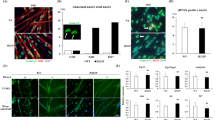Summary
Hypoblast and definitive endoblast derived from young chick embryos were explanted and grown for 24 h in culture. The junctional complexes which characterise these tissues were studied on freeze-fracture replicas and thin sections. Cell membranes of the hypoblast displayed tight junctions only, disposed in randomly arranged strands or narrow belts which included many discontinuous strands. The definitive endoblast showed tight and gap junctions as well as desmosomes in close association with the tight junctions. It is suggested that the differences between the two types of tissue may be related to cell cohesiveness, which appears to be relatively low in the hypoblast and high in the definitive endoblast.
Similar content being viewed by others
References
Bellairs R (1981 in press) Gastrulation processes in the chick embryo. In: Bellairs R, Curtis ASG, Dunn GG (eds) Cell behaviour: A tribute to Michael Abercrombie. Cambridge University Press
Bellairs R, Breathnach AS, Gross M (1975) Freeze-fracture replication of junctional complexes in unincubated and incubated chick embryos. Cell Tissue Res 162:235–252
Bellairs R, Ireland GW, Sanders EJ, Stern CD (1981) The behaviour of embryonic chick and quail tissues in culture. J Embryol Exp Morphol 61:15–33
Bennett MVL, Trinkaus JP (1970) Electrical coupling between embryonic cells by way of extracellular space and specialized junctions. J Cell Biol 44:592–610
Claude P, Goodenough DA (1973) Fracture faces of zonulae occludentes from “tight” and “leaky” epithelia. J Cell Biol 58:390–400
Eyal-Giladi H, Kochav S (1976) From cleavage to primitive streak formation: a complementary normal table and a new look at the first stages of the development of the chick. Dev Biol 49:321–337
Gilula NB (1974) Junctions between cells. In: Cox RP (ed) Cell communications. John Wiley & Sons, New York
Hamburger V, Hamilton HL (1951) A series of normal stages in the development of the chick embryo. J Morphol 88:49–92
Hirakow R, De Haan RL (1970) Synchronization and the formation of nexal junctions between isolated chick embryonic heart myocytes beating in culture. J Cell Biol 47:88a
Martinez-Palomo A, Erlij D (1975) Structure of tight junctions in epithelia with different permeability. Proc Natl Acad Sci USA 72:4487–4491
McNutt NS (1977) Freeze-fracture techniques and applications to the structural analysis of the mammalian plasma membrane. In: Poste G, Nicholson GL, (eds) Cells surface reviews Vol. 3 Dynamic aspects of cell surface organization. North Holland, pp 75–126
Montesano R, Friend DS, Perrelet A, Orci L (1975) In vivo assembly of tight junctions in fetal rat liver. J Cell Biol 67:310–319
Peracchia C (1980) Structural correlates of gap junction permeation. Int Rev Cytol 66:81–146
Pfenninger KH, Rinderer ER (1975) Methods for the freeze-fracture of nerve tissue cultures and cell monolayers. J Cell Biol 65:15–28
Porvaznik M, Johnson RG, Sheridan JD (1979) Tight junction development between cultured hepatoma cells. Possible stages in essembly and enhancement with dexamethasone. J Supramol Struct 10:13–30
Revel J-P (1974) Some aspects of cellular interactions in development. In: Moscona AA (ed) The cell surface in development. John Wiley & Sons, New York, pp 51–65
Sanders EJ, Prasad S (1981,in press) Contact inhibition of locomotion and the structure of homotypic and heterotypic intercellular contacts in embryonic epithelial cultures. Exp Cell Res
Sanders EJ, Bellairs R, Portch PA (1978) In vivo and in vitro studies on hypoblast and definitive endoblast of avian embryos. J Embryol Exp Morphol 46:187–205
Sheridan JD (1971) Dye movement and low-resistance junctions between reaggregated embryonic cells. Biol 26:627–636
Sheridan JD (1974) Electrical coupling of cells and cell communication. In: Cox RP (ed) Cell communication. John Wiley & Sons, New York, pp 30–42
Sheridan JD (1976) Low-resistance junctions: some functional considerations. In: Moscona AA (ed) The cell surface in development. John Wiley, New York, pp 187–206
Staehelin LA (1974) Structure and function of intercellular junctions. Int Rev Cytol 39:191–283
Stolinski C (1975) Freeze-fracture replication apparatus for biological specimens. J Microsc 104:235–244
Stolinski C (1977a) Unusual features of plasma membrane of chick neural tube cells as seen on freeze-fracture replicas. J Anat 124:242–243
Stolinski C (1977b) Freeze-fracture replication in biological research: development, current practice and future prospects. Micron. 8:87–111
Trelstad RL, Hay ED, Revel J-P (1967) Cell contact during early morphogenesis in the chick embryo. Dev Biol 16:78–106
Author information
Authors and Affiliations
Rights and permissions
About this article
Cite this article
Stolinski, C., Sanders, E.J., Bellairs, R. et al. Cell junctions in explanted tissues from early chick embryos. Cell Tissue Res. 221, 395–404 (1981). https://doi.org/10.1007/BF00216743
Accepted:
Issue Date:
DOI: https://doi.org/10.1007/BF00216743




